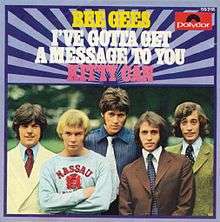Kitty Can
| "Kitty Can" | |||||||||||||||
|---|---|---|---|---|---|---|---|---|---|---|---|---|---|---|---|
 | |||||||||||||||
| Single by Bee Gees | |||||||||||||||
| from the album Idea | |||||||||||||||
| A-side | "I've Gotta Get a Message to You" | ||||||||||||||
| Released | 7 September 1968 | ||||||||||||||
| Format | 7", 45rpm | ||||||||||||||
| Recorded | 12 June 1968 | ||||||||||||||
| Genre | Psychedelic pop | ||||||||||||||
| Length |
2:31 (mono) 2:38 (stereo) 2:36 (stereo, with orchestra) | ||||||||||||||
| Label |
Polydor (United Kingdom) Atco (United States) | ||||||||||||||
| Writer(s) | Barry, Robin & Maurice Gibb | ||||||||||||||
| Producer(s) | Robert Stigwood, Bee Gees | ||||||||||||||
| Bee Gees flipsides chronology | |||||||||||||||
| |||||||||||||||
"Kitty Can" is a song by the Bee Gees, released as the B-side of "I've Gotta Get a Message to You" in July 1968, and released as the second track on their album Idea in September 1968.[1][2] It was written and composed by Barry, Robin & Maurice Gibb. Its stereo version faded at 2:38 was released in the US version of the album and the stereo with orchestra version was released in 2006 on The Studio Albums 1967-1968.[3] In 1973, the RSO Records released a compilation called Kitty Can only in Uruguay, and this song appeared as the first track on that album.[4]
The music video of this song features only the three Gibb brothers and not Colin Petersen or Vince Melouney. Robin is notably miming playing guitar on the video. The video was televised in 192 TV.[5]
Background
Barry Gibb explained about the song:
| “ | 'Kitty Can' was written by Maurice and I, during a night with Maurice and Lulu at their place in London, the early apartment shared before they moved to Hampstead". That was [Mick] Jagger-influenced. In those days, of course, everything was either The [Rolling] Stones or The Beatles, and everybody wanted to be in that sort of zone. So I think that it was certainly influenced by that. 'The Earnest Of Being George' was also influenced by them. Sometimes, Vince Melouney, because he was a rocker at heart, would influence us. I remember Vince on 'Idea'. It was wanting to do something with more aggression, with more energy. That's my greatest memory of it, looking for something that was a little more angry and that just came out in the studio".[6] | ” |
The Bee Gees returned to IBC Studios on June 12 after they recorded three songs in Polydor Studios, On that same day, the Bee Gees recorded "Kitty Can", "I.O.I.O.", "Let There Be Love" and the unreleased track "No Name"..[7]
The demo included on the remastered edition of the album in 2006 is similar to the final version but has some additional ad-libbed almost jazz scat backing vocals (probably by Maurice). Maurice’s higher vocal is more prevalent on this version.[8]
Track listing
| No. | Title | Writer(s) | Length |
|---|---|---|---|
| 1. | "I've Gotta Get a Message to You" | Barry Gibb, Robin Gibb, Maurice Gibb | 2:59 |
| 2. | "Kitty Can" | Barry Gibb, Robin Gibb, Maurice Gibb | 2:31 |
Personnel
- Barry Gibb — Lead and harmony vocal, guitar
- Maurice Gibb — Lead and harmony vocal, bass
- Vince Melouney — guitar
- Colin Petersen — drums
References
- ↑ Discogs.com. "Bee Gees: I've Gotta Get a Message to You / Kitty Can".
- ↑ Discogs.com. "Bee Gees: Idea".
- ↑ Joseph Brennan. "Gibb Songs: 2006".
- ↑ Discogs.com. "Bee Gees: Kitty Can (LP)".
- ↑ "The Bee Gees - Kitty Can ( Rare Lost Original Promo Film 1968 Probably French TV 1968 )". YouTube. 2013-06-27. Retrieved 2014-06-07.
- ↑ Sandoval, Andrew. "Bee Gees - Idea at Album Liner Notes". Album Liner Notes. Retrieved 21 May 2013.
- ↑ Joseph Brennan. "Gibb Songs: 1968".
- ↑ Bennett, Kevin (2011-03-22). "Bee Gees Demos – Part 2 | A Kick In The Head". Kickinthehead8inthepants.wordpress.com. Retrieved 2014-06-07.